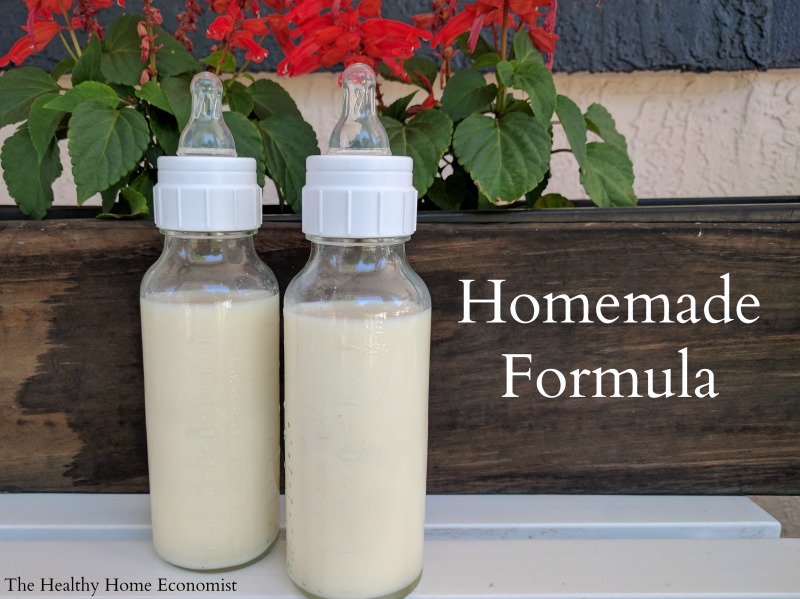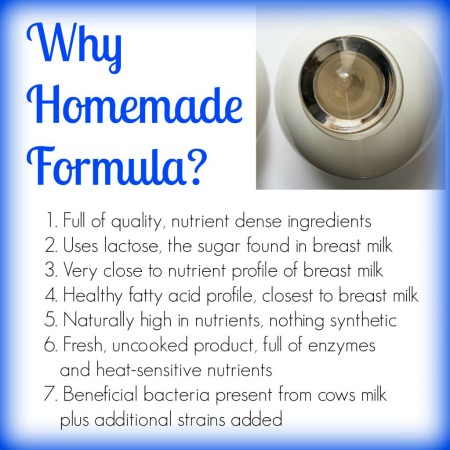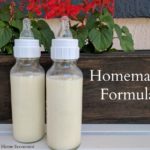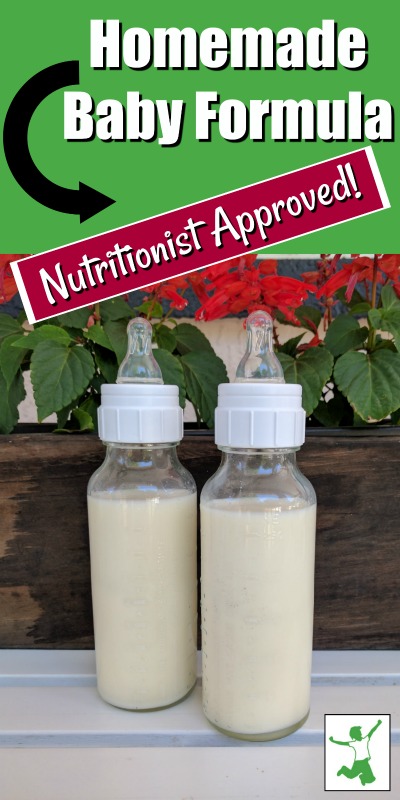Table of Contents[Hide][Show]
A nourishing homemade baby formula using safe, whole ingredients. This recipe was developed and tested by Dr. Mary Enig, a PhD Nutritionist and originally published in Nourishing Traditions cookbook in 1996. It was formulated to match breastmilk as closely as possible and is also suitable for infants. Source: Weston A. Price Foundation

There is no doubt that breastfeeding your baby is the best option for the child’s long-term health and development. Human breastmilk from a well-nourished mother is the perfect food for baby. However, in circumstances where the child is adopted or the Mother finds herself unable to breastfeed, formula feeding becomes necessary. In those cases, homemade baby formula is best.
Using a baby formula recipe that closely matches the nutritional profile of breastmilk is a far better choice than even organic baby formula from the health food store. More on this below.
Note: Donor programs are widely available for human breastmilk. But, the diets of the donor mothers are unknown and most likely nutritionally insufficient. In addition, breastmilk banks pasteurize the donated breastmilk which destroys much of the nutritional benefit. Unless you are fortunate to have a trusted and direct donor milk source in your community, avoid this option!
Dangers of Commercial Formula
Commercial formulas are always a poor choice for a number of reasons. First of all, formula manufacturers line the cans with the chemical BPA. This substance disrupts hormone development and is a probable contributor to early puberty in girls, and ADHD, urogenital abnormalities, and other ills in boys.
The European Food Safety Authority found that canned commercial formula is a significant source of BPA for infants, exposing the child to 13mcg of BPA per kg of body weight per day! BPA-free formula cans are no better. The chemical BPS is typically used instead which is just as dangerous.
Beware that manufacturers pack even organic commercial formula like Earth’s Best in BPA cans. Worse, they use organic brown rice syrup as the primary sweetener which is known to be frequently contaminated with arsenic.
In addition, all commercial milk formulas are processed at extremely high temperatures which violently denature the fragile milk proteins, render them allergenic, and add carcinogens to the final product. Soy infant formula is the worst. Obscenely high processing temperatures not only denature the proteins but large levels of phytic acid in soy block mineral absorption by the infant. Moreover, soy-based plant estrogens disrupt the hormonal development of the baby!
It seems that for the concerned Mother who is unable to breastfeed, learning how to make baby formula at home with safe, pure ingredients is the most prudent way to go!
Why Make Homemade Formula Even if You Are Breastfeeding
In the video below, I show you how to make your own safe, healthy raw milk homemade formula for your baby.
The recipe I follow was originally published in the cookbook Nourishing Traditions in 1996 and developed by Dr. Mary Enig.
Even though I breastfed each of my children for at least 2 years, I made this exact formula for my own children when I was away for the day or the evening as pumping was not an option that worked well for me.
I even used this homemade formula for an entire day once when I had some dental work done and was advised to pump and discard for 24 hours.
As a result, even successfully breastfeeding Moms can use this wonderful homemade formula as a supplement when necessary to their own nutrient-dense breastmilk!
It is advised that even breastfeeding Mothers have the ingredients for this formula on hand for an emergency. If Mom is sick or otherwise unable to nurse, Dad can step in and make this safe alternative until Mom is back on her feet. It takes a few days to a week to gather all the ingredients together to make this formula, which is why I advise having them on hand at all times.
Homemade Most Nutritious
The image below lists the reasons why it is worth it nutritionally to make formula yourself for your precious baby!
You can order all of the required ingredients for the homemade baby formula in one package from this reputable, vetted source.
Moms who have successfully used this formula feeding your children, please post about your experience in the comments section to encourage those who are considering it and need some Mom to Mom encouragement!

Where to Source Quality Milk
The most widely available grass-fed milk around the world is from cows. This is usually the most budget-friendly and easily sourced milk for this recipe for homemade formula.
If only goat milk is available in your area, this recipe for goat milk baby formula can be used instead. When using milk from ewes, please refer to the linked article for an adjusted recipe; one of the benefits of sheep milk is that it is higher in healthy fats than either goat or cow milk.
Camel milk formula is another option that is a particularly digestible form of dairy and growing in popularity around the world.
Alternatively, you can use low temp (vat) pasteurized, non-homogenized whole milk cultured with a piima or kefir starter. Then substitute the piima milk or kefir for the raw milk portion of the formula recipe. Cold-pressed raw milk also must be cultured before using it as it contains no probiotics.
Do NOT use ultrapasteurized (UHT) milk even if organic as it is too highly processed and extremely allergenic!
It is also best to avoid all types of powdered milk for this recipe. The factory process of making milk powder reduces nutrition considerably and denatures it, which makes it more likely baby will have an allergic reaction.
Dairy Allergy Option
If all types of dairy prove unsuitable for your baby, make this nondairy baby formula recipe instead. It uses a base of homemade bone broth as a substitute for milk. It is important not to utilize a plant-based or otherwise vegan baby formula recipe.
Avoid buying bone broth to make the dairy-free formula. Make it yourself! Manufacturers of commercial bone broth, even if authentic, may water down the end product. This is apparent if it does not gel when chilled in the refrigerator.
Many brands have toxic packaging issues as well. If you must buy it in a pinch, see my shopping guide page for vetted brands that are safe.

Homemade Baby Formula Recipe (for infants too)
A nourishing baby formula recipe you can make at home with safe, whole ingredients developed and tested by a PhD nutritionist to match breastmilk as closely as possible. Also suitable for infants.
Ingredients
- 2 cups raw cow milk OR organic whole milk yogurt
- 1 7/8 cups filtered water
- 1/4 cup liquid whey
- 4 Tbl lactose
- 1/4 tsp Bifidobacterium infantis powder
- 2-4 Tbl raw or pasteurized cream
- 1/2 tsp cod liver oil unflavored
- 1/4 tsp butter oil unflavored
- 1 tsp sunflower oil preferably organic
- 1 tsp extra virgin olive oil preferably organic
- 2 tsp virgin coconut oil preferably organic
- 2 tsp nutritional yeast
- 2 tsp gelatin
- 1/4 tsp acerola powder
Instructions
-
Fill a 2 cup Pyrex measuring cup with filtered water and remove 2 TBL (this will give you 1 7/8 cup water).
-
Pour about half the water into a pan and turn burner on medium.
-
Add the gelatin and lactose and let dissolve, stirring occasionally.
-
When gelatin and lactose are dissolved, remove pan from heat and add the rest of the water to cool.
-
Stir in the coconut oil and butter oil until melted.
-
Put remaining ingredients in a glass blender.
-
Add the water mixture and blend for about 3 seconds.
-
Place formula in glass baby bottles or a glass jar and refrigerate.
-
Before giving to baby, warm glass bottle in a pan of hot water or a bottle warmer. NEVER microwave baby bottles!
Recipe Video
Recipe Notes
If using raw cow milk from holstein cows, use 4 Tbl of extra cream (otherwise use 2 Tbl extra cream).
If choosing to make this homemade formula with camel milk, be sure to include 4 Tbl extra cream as camel milk is lower in cream than cow milk.
Do not use high oleic sunflower oil. Use only the brand recommended in the ingredients list which is cold pressed, organic, unrefined, and low oleic.
*Do NOT use powdered whey from the store as it is denatured. Avoid whey from making cheese as it will curdle the formula.
*Do not substitute pasteurized or powdered milk as these are heavily processed, denatured and allergenic foods.
*Do NOT use ultrapasteurized (UHT) cream. It is highly allergenic. Raw or pasteurized cream is acceptable.
*Do NOT use fish oil or krill oil instead of high vitamin cod liver oil as they do not contain any Vitamin D and very little to no Vitamin A.
Collagen powder may be substituted for the gelatin in a pinch (more on peptides in baby formula in this article).
If you are wondering where is the iron in homemade baby formula, this article provides an explanation.
If baby experiences constipation using this formula, try adding 1 tsp of molasses to each batch. This should help move things along.
How to Transition to DIY Formula
Once you’ve viewed the video, gathered the ingredients, and made your first batch, how do you feed it to your baby for the first time?
It is important not to switch all at once as this can cause gas, excessive spit-up, or an uncomfortable change in diaper habits such as constipation or overly loose stools.
Start by giving your baby three-quarters of the old formula blended with one-quarter of the homemade. Try this ratio for a day or two and see how your infant responds.
If no digestive upset or major change in diaper habits occurs, increase the amount to a 50-50 blend of old formula to homemade. Observe for another day or two as before.
If no major issues, increase once again to three-quarters homemade formula to one-quarter old formula. If baby does well on this blend for a third time, you are ready to fully transition to the homemade formula.
At any time during the transition, symptoms of intolerance emerge, back up to the previous successful blend ratio and stay there for a day or two before attempting to increase once again.
Homemade Formula FAQ
Weston Price Foundation
Feeding an Adopted Baby
Traveling Tips with Baby Formula Made at Home
Iron in Baby Formula
Collagen Peptides instead of Gelatin for Homemade Formula?










Can anyone relate?!?!?….After a couple weeks of formula feeding my son he started having blood in his poop….the doctor put him on Nutramigen because apparently this was caused by a milk allergy. Has anyone tried the raw milk formula who’s baby had the same allergic reaction? I read that a baby is “allergic” to cows milk because it is so processed, they can’t digest it. I am praying he doesn’t get blood in his poop and he accepts this formula. I did my research on commercial formula and it breaks my heart every bottle I give him.
Sarah,
Next month we will be adopting our first child & are so excited. I know that commercial formulas are terrible so thank you for showing this information. I am unable to find a source for raw milk at this time so I am planning to go the low temp pasteurized milk route & culture it with kefir grains. I was wondering though, what brand of cream you would recommend since I will not have raw milk source for good quality cream & most pasteurized creams are ultra pasteurized? Thank you for your help!
I was wondering if there was a way to add DHA and ARA to this homemade baby formula recipe?
I was wondering if you could add a source of DHA and ARA to homemade formula?
the cod liver oil is the dha. the ara is from the fat in the milk.
Would this formula work well for preemies? My baby boy was born at 31 weeks and is anemic. Are there any natural formula vitamin/mineral/iron supplements you could recommend for him?
This formula is great. I used it myself for a tube-fed child when I couldn’t keep up my milk supply. However, our child couldn’t tolerate cow milk and we had to use goat milk. Goat milk can be done safely and efficiently with a few tweaks to the recipe. Don’t write it off just for the sake of keeping to the exact recipe. You can still make it work and meet all the nutritional requirements needed for good health.
April, your comment interests me a lot as I use the homemade baby formula with cow’s milk. My baby has eczema and some intolerance to cow’s milk. I have the chance to buy goat’s milk (they eat fermented food along with what they can find in Nature and they even eat algi from the beach) but I have some concerns.
What changes did you make in your formula? I am looking forward to reading your answer as I do not want my baby to lack in folate, iron and B12, for example. Thank you very much!
Maria.
Maria, unsulphured blackstrap molasses can be used as part of the carbohydrate intake for iron. It also helped keep my child really regular. We rarely had constipation issues (and if they did we were able to get them immediately resolved). We did use quality multi vitamins to make up some of the content, but my child was also older than six months when we started giving them this formula. We were able to add meat and other foods to help with vitamin and mineral content. I do think with the formula it is important to introduce organic, whole food and homemade baby food once they are old enough. The Weston A. Price original formula suggests adding grated liver to the formula if you use goat milk.
Also, the nutritional yeast makes up a large portion of the b-vitamins and folic acid. If you use goat milk, be sure to include that. I can’t remember all the specifics on infants off the top of my head, but it may be sufficient in covering the folic acid and b-vits.
April thank you so much for your answers! I gave goat milk’s formula but she vomited it so I gave that option up immediately. It’s impossible to find chicken liver here so I went back to cow’s milk formula… however, as time goes by (she’s 11 months now) her sleep patterns are really bad. She only sleeps 7-8 hours per night and 1 hour per day only… and I am soooooo tired!
Her sleep patterns were soooo good until I introduced some solids (vegetables I think). I give her a whole foods diet consisting on egg yolks, liver, bone broth, chicken, turkey, grassfed butter, vegetables like carrots / brocoli / lettuce / onions / napa or nappa cabbage / squash / pumpkin / parsley / cauliflower and fruits like avocados / apples / pears / (avoid banana and she gets constipated) for example… what am I doing wrong? 🙁
Forgot to mention that she doesn’t have any teeth yet.
Have you tried culturing the goat milk or even using goat milk yogurt? I makes the milk more digestible.
Hi Sarah,
Wonderful video! While watching it, I realized this is the same recipe as found in the book ‘Super Nutrition for Babies’ by K. Erlich & K. Genzlinger. I use this book daily for its wonderful baby recipes.
My son will be going to a nanny starting at 10.5 months, transitioning him slowly into this new environment so at one years time he will be there full time while I return to work.
My son has a full body rash and has since food was introduced. Otherwise, he is very healthy. I suspect he has some sensitivities.
I live in a rural community in Northern BC, Canada. Unfortunately, because raw dairy is “illegal” here, it is very difficult to find it from a trusted source. I have however found raw goat milk dairy (also illegal, but the individuals claim its for pets in order to let people get away with drinking it – a trusted source). I realize however it is significantly lower in folic acid and B12 vitamin, both imperative for a babies growth and development.
My question is, would you recommend using raw goats milk instead of raw cow milk in the above recipe (as it seemingly might be my only choice for raw dairy) and adding a few additional ingredients to address the folic and B12 needs? In my book it talks about chicken livers. This idea for whatever reason does not sit well with me???
Despite him going to a nanny each day, I do intend to breastfeed my son in the am when he wakes, when I return from work each day and before his bedtime. I may also increase my pumping to send him with one bottle of breastmilk a day for the nanny. This extra formula is just to get his some additional milk that I believe he will require over and above what I can give him breastfeeding/pumping.
What are your recommendations? Would you advise that I use the raw goat milk and add a few substitutes, or would you advise that I use the low temp, non homo whole cow milk in glass. Truthfully, I dont even know if I can find that up here in the north.
Thank you for your time Sarah.
Roxy
you have to be careful when changing the formula because it can have ripple effects. the nutrients work (or don’t work) in certain combinations. they can also block each other in the wrong combinations. the weston a price foundation has a goats milk formula. yeah it has liver. you should just address your uneasiness about liver. it does not hold toxins, the liver converts toxins to get rid of them. it is healthy, as long as it comes from a healthy animal. it is actually a super food. i’d try it. baby doesn’t have any preconceived notions about liver.
I get the glass baby bottles at Target for super cheap, and just pour the batch of formula into the bottles and store in the fridge. When it’s time for a bottle, I warm it in the a bowl or pan of hot water for a couple minutes to help the formula mix together properly. Super easy 🙂
To everyone wondering about the formula ‘setting up’ overnight….
I was having the same problem and even threw out a batch thinking it had gone bad. But now that I’ve made it a few times, I think that it’s just the oils hardening due to the cold. All I do is give the jar some really good shakes before pouring to be sure and distribute all the solidified oils throughout. I haven’t had any issues.
Hi, I had this problem too and I started using only one tsp of the gelatin and that solved it. I still have to shake it a bit, but just to distribute the cream. Hope that helps!
I put the Nutritional Yeast Flakes and the Acerola Powder in with the warm water to help it dissolve first before mixing with the rest of the formula.